1. In an IPv4 environment, what information is used by the router to forward data packets from one interface of a router to another?
destination network addresssource network address
source MAC address
well known port destination address
source MAC address
well known port destination address
2. What information is added during encapsulation at OSI Layer 3?
source and destination MAC
source and destination application protocol
source and destination port number
source and destination IP address
source and destination MAC
source and destination application protocol
source and destination port number
source and destination IP address
3. In a connectionless system, which of the following is correct?
The destination is contacted before a packet is sent.
The destination is not contacted before a packet is sent.The destination sends an acknowledgement to the source that indicates the packet was received.
The destination sends an acknowledgement to the source that requests the next packet to be sent.
The destination is contacted before a packet is sent.
The destination is not contacted before a packet is sent.The destination sends an acknowledgement to the source that indicates the packet was received.
The destination sends an acknowledgement to the source that requests the next packet to be sent.
4. Which IP packet field will prevent endless loops?
type-of-service
identification
flags
time-to-liveheader checksum
type-of-service
identification
flags
time-to-liveheader checksum
5. Which portion of the network layer address does a router use to forward packets?
host portion
broadcast address
network portiongateway address
host portion
broadcast address
network portiongateway address
6.
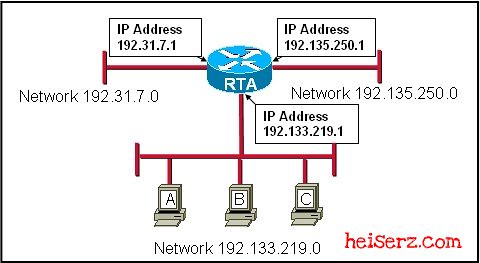
Refer to the exhibit. Using the network in the exhibit, what would be the default gateway address for host A in the 192.133.219.0 network?
192.135.250.1
192.31.7.1
192.133.219.0
192.133.219.1

Refer to the exhibit. Using the network in the exhibit, what would be the default gateway address for host A in the 192.133.219.0 network?
192.135.250.1
192.31.7.1
192.133.219.0
192.133.219.1
7. If the default gateway is configured incorrectly on the host, what is the impact on communications?
The host is unable to communicate on the local network.
The host can communicate with other hosts on the local network, but is unable to communicate with hosts on remote networks.The host can communicate with other hosts on remote networks, but is unable to communicate with hosts on the local network.
There is no impact on communications.
The host is unable to communicate on the local network.
The host can communicate with other hosts on the local network, but is unable to communicate with hosts on remote networks.The host can communicate with other hosts on remote networks, but is unable to communicate with hosts on the local network.
There is no impact on communications.
8. What is the purpose of a default gateway?
physically connects a computer to a network
provides a permanent address to a computer
identifies the network to which a computer is connected
identifies the logical address of a networked computer and uniquely identifies it to the rest of the network
identifies the device that allows local network computers to communicate with devices on other networks
physically connects a computer to a network
provides a permanent address to a computer
identifies the network to which a computer is connected
identifies the logical address of a networked computer and uniquely identifies it to the rest of the network
identifies the device that allows local network computers to communicate with devices on other networks
9. What type of routing uses information that is manually entered into the routing table?
dynamic
interior
staticstandard
dynamic
interior
staticstandard
10. When the destination network is not listed in the routing table of a Cisco router, what are two possible actions that the router might take? (Choose two.)
The router sends an ARP request to determine the required next hop address.
The router discards the packet.The router forwards the packet toward the next hop indicated in the ARP table.
The router forwards the packet to the interface indicated by the source address.
The router forwards the packet out the interface indicated by the default route entry.
The router sends an ARP request to determine the required next hop address.
The router discards the packet.The router forwards the packet toward the next hop indicated in the ARP table.
The router forwards the packet to the interface indicated by the source address.
The router forwards the packet out the interface indicated by the default route entry.
11. What are the key factors to consider when grouping hosts into a common network? (Choose three.)
gateways
purposephysical addressing
software version
geographic locationownership
gateways
purposephysical addressing
software version
geographic locationownership
12. What is a component of a routing table entry?
the MAC address of the interface of the router
the destination Layer 4 port number
the destination host address
the next-hop address
the MAC address of the interface of the router
the destination Layer 4 port number
the destination host address
the next-hop address
13. Which intermediary devices could be used to implement security between networks? (Choose two.)
routerhub
switch
firewallaccess point
bridge
routerhub
switch
firewallaccess point
bridge
14. What are three common problems with a large network? (Choose three.)
too few broadcasts
performance degradationsecurity issueslimited management responsibility
host identificationprotocol compatibility
too few broadcasts
performance degradationsecurity issueslimited management responsibility
host identificationprotocol compatibility
15.
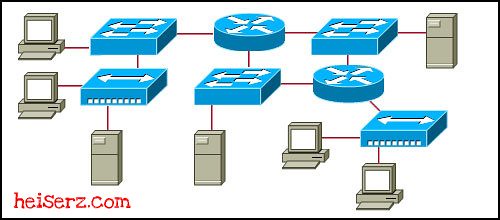
Refer to the exhibit. All devices shown in the exhibit have factory default settings. How many broadcast domains are represented in the topology that is shown?
3
45
7
8
11

Refer to the exhibit. All devices shown in the exhibit have factory default settings. How many broadcast domains are represented in the topology that is shown?
3
45
7
8
11
16. Which three statements are true about routes and their use? (Choose three.)
If no route to the destination network is found, the packet is returned to the previous router.
If the destination network is directly connected, the router forwards the packet to the destination host.
If multiple network entries exist for the destination network, the most general route is used to forward the packet.
If no route exists for the destination network and a default route is present, the packet is forwarded to the next-hop router.
If the originating host has a default gateway configured, the packet for a remote network can be forwarded using that route.
If a host does not have a route manually configured for the destination network, the host will drop the packet.
If no route to the destination network is found, the packet is returned to the previous router.
If the destination network is directly connected, the router forwards the packet to the destination host.
If multiple network entries exist for the destination network, the most general route is used to forward the packet.
If no route exists for the destination network and a default route is present, the packet is forwarded to the next-hop router.
If the originating host has a default gateway configured, the packet for a remote network can be forwarded using that route.
If a host does not have a route manually configured for the destination network, the host will drop the packet.
17.
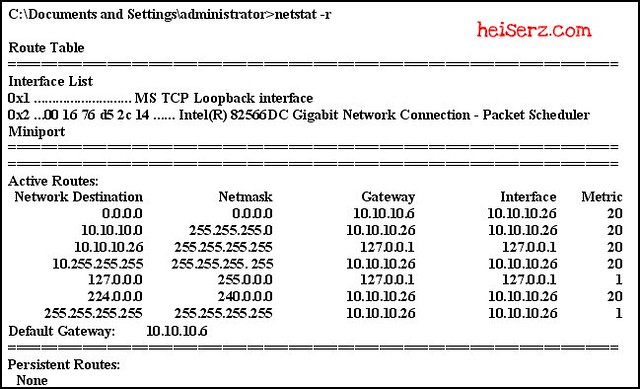
Refer to the exhibit. A network administrator is troubleshooting a connectivity problem and needs to determine the address that is used to forward network packets out the network. Using the netstat -r command, the administrator would identify which address as the address to which all hosts send packets that are destined for an outside network?
10.10.10.26
127.0.0.1
10.10.10.610.10.10.1
224.0.0.0

Refer to the exhibit. A network administrator is troubleshooting a connectivity problem and needs to determine the address that is used to forward network packets out the network. Using the netstat -r command, the administrator would identify which address as the address to which all hosts send packets that are destined for an outside network?
10.10.10.26
127.0.0.1
10.10.10.610.10.10.1
224.0.0.0
18.
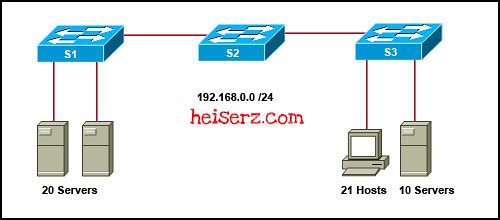
Refer to the exhibit. A network administrator notices that there are too many broadcasts on the network. What two steps can the network administrator take to resolve this problem? (Choose two.)
Replace S2 with a router.Place all servers on S1.
Disable TCP/IP broadcasts.
Subnet the 192.168.0.0 /24 network.Disable all unused interfaces on the switches.

Refer to the exhibit. A network administrator notices that there are too many broadcasts on the network. What two steps can the network administrator take to resolve this problem? (Choose two.)
Replace S2 with a router.Place all servers on S1.
Disable TCP/IP broadcasts.
Subnet the 192.168.0.0 /24 network.Disable all unused interfaces on the switches.
19.
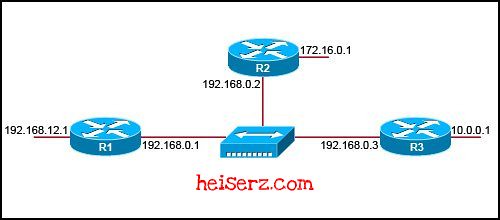
Refer to the exhibit. The network in the exhibit is fully operational. What two statements correctly describe the routing for the topology that is shown? (Choose two.)
192.168.0.2 is the next-hop address that is used by R3 to route a packet from the 10.0.0.0 network to the 172.16.0.0 network.10.0.0.1 is the next-hop address that is used by R1 to route a packet from the 192.168.12.0 network to the 10.0.0.0 network.
192.168.0.1 is the next-hop address that is used by R1 to route a packet from the 192.168.12.0 network to the 172.16.0.0 network.
172.16.0.1 is the next-hop address that is used by R3 to route a packet from the 10.0.0.0 to the 172.16.0.0 network.
192.168.0.1 is the next-hop address that is used by R2 to route a packet from the 172.16.0.0 network to the 192.168.12.0 network.192.168.0.2 is the next-hop address that is used by R2 to route a packet from the 172.16.0.0 network to the 192.168.12.0 network.

Refer to the exhibit. The network in the exhibit is fully operational. What two statements correctly describe the routing for the topology that is shown? (Choose two.)
192.168.0.2 is the next-hop address that is used by R3 to route a packet from the 10.0.0.0 network to the 172.16.0.0 network.10.0.0.1 is the next-hop address that is used by R1 to route a packet from the 192.168.12.0 network to the 10.0.0.0 network.
192.168.0.1 is the next-hop address that is used by R1 to route a packet from the 192.168.12.0 network to the 172.16.0.0 network.
172.16.0.1 is the next-hop address that is used by R3 to route a packet from the 10.0.0.0 to the 172.16.0.0 network.
192.168.0.1 is the next-hop address that is used by R2 to route a packet from the 172.16.0.0 network to the 192.168.12.0 network.192.168.0.2 is the next-hop address that is used by R2 to route a packet from the 172.16.0.0 network to the 192.168.12.0 network.
20. What two characteristics are commonly associated with dynamic routing protocols? (Choose two.)
require no device configuration
provide routers with up-to-date routing tablesrequire less processing power than static routes require
consume bandwidth to exchange route informationprevent manual configuration and maintenance of the routing table
require no device configuration
provide routers with up-to-date routing tablesrequire less processing power than static routes require
consume bandwidth to exchange route informationprevent manual configuration and maintenance of the routing table
21. What statement describes the purpose of a default route?
A host uses a default route to transfer data to another host on the same network segment.
A host uses a default route to forward data to the local switch as the next hop to all destinations.
A host uses a default route to identify the Layer 2 address of an end device on the local network.
A host uses a default route to transfer data to a host outside the local network when no other route to the destination exists.
A host uses a default route to transfer data to another host on the same network segment.
A host uses a default route to forward data to the local switch as the next hop to all destinations.
A host uses a default route to identify the Layer 2 address of an end device on the local network.
A host uses a default route to transfer data to a host outside the local network when no other route to the destination exists.